Korean fir: description, varieties, planting and care
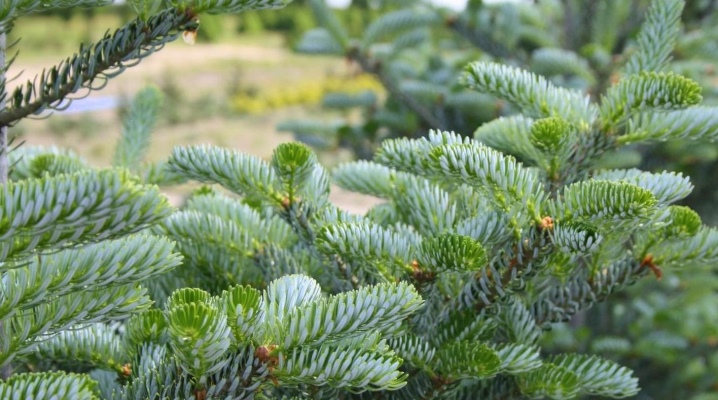
Among gardeners, the Korean fir is deservedly popular due to its unpretentiousness, winter hardiness, endurance and decorative appearance that persists all year round. The tree is actively used in landscape design, in addition, its medicinal qualities are highly appreciated, contributing to the disinfection of the air and the elimination of infections and pests on the site.
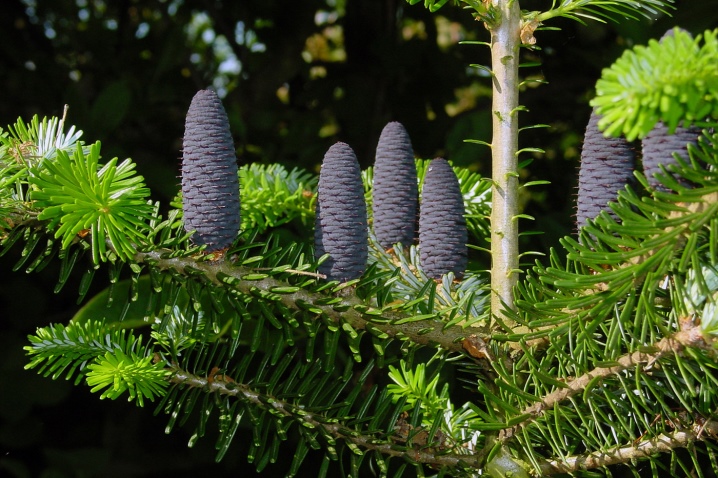
Description
The Abies koreana fir is a tree belonging to the pine family. In the natural environment, it grows in the northern regions, coniferous and mixed forests, on the slopes of mountains, reaching a height of 15 m or more.
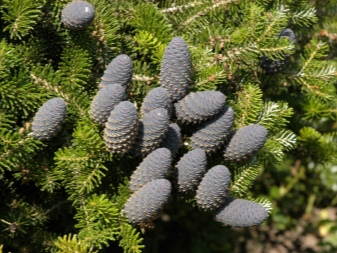
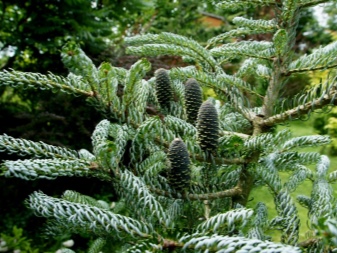
Species characteristics.
- The crown has a conical, sometimes pyramidal shape, and the circumference of its trunk is 0.5-0.8 m.
- A distinctive feature of the ephedra is the impressive size of the crown, the culture grows rapidly in breadth, but differs in slow growth in height.
- Korean evergreen fir has a well-developed and powerful root system.
- The bark of small firs is gray-silver, thin and smooth, but with age it increases in thickness, acquires a reddish-brown tint, and becomes covered with cracks.
- Young shoots are yellowish in color, but over the years it changes to purple. The buds forming on them have a spherical shape and contain a large amount of odorous resin with a pleasant coniferous aroma.
- The color of the needles is bright, emerald on the outside of the needles, and on the inside of the needles they have silvery veins.
- The edges of the needles are slightly bent - on young trees they are prickly and hard, in adult specimens they have a smoother, blunt end. The length of the needles is 20 mm and the width is about 2.5 mm.
- Fir branches with blue cones, which have a purple hue and a cylindrical shape, look beautiful. The fruits of the tree are quite large - up to 7-8 cm in length and up to 3 cm in diameter. Usually, they are formed in the upper part of the crown on fresh shoots.
- When the seeds ripen, the scales covering them harden, going through the lignification process, and fall off, and the seed material is carried by the wind. By the way, the pollination of cones also occurs due to the movement of air masses.

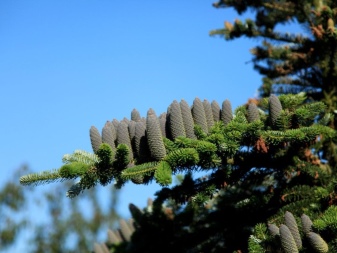
A tree has an average lifespan of about 150-200 years, but under natural conditions a tree can live 300-400 years. Korean fir prefers alkaline and acid-neutral soils. Under unfavorable conditions and unsatisfactory care, its growth is inhibited and it does not reach its optimal height. As a result, the plant looks more like a shrub with a rounded crown shape.
The culture tolerates subzero temperatures well, but feels uncomfortable in dry and hot weather. Unlike some conifers, this species is sensitive to any change in the composition of the air, especially to the gas pollution typical for the city. This excludes the possibility of planting it along highways and highways.
This coniferous species is considered a useful crop, and gardeners appreciate it not only for the beauty of some species, but also for the tree's ability to purify the air and prevent the attack of harmful insects thanks to volatile disinfectants - phytoncides secreted by needles.
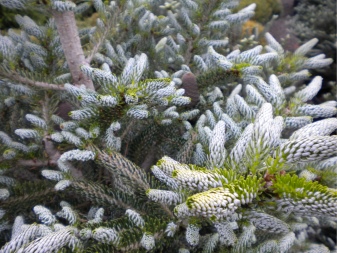
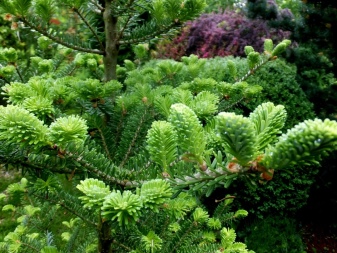
Types and varieties
The plant has a large number of artificially bred varieties and species that are suitable for landscaping and decoration of both private territories and city parks and squares.
Listed below are the most sought-after crops, suitable for a wide variety of regions. After familiarizing yourself with the main features of these varieties, you can choose the right variety for your own territory.
- Miniature tree "Compact" belongs to a dwarf variety of Korean fir and can grow up to 80 cm, adding 5-6 cm per year. It has long beautiful needles of a silvery-blue color, which is its main decorative value and compensates for the rare formation of cones.
Ephedra can be grown in flowerpots, used to decorate verandas and the front entrance. Also, fir plantings frame garden paths, are planted as part of compositions including artificial ponds and stones.
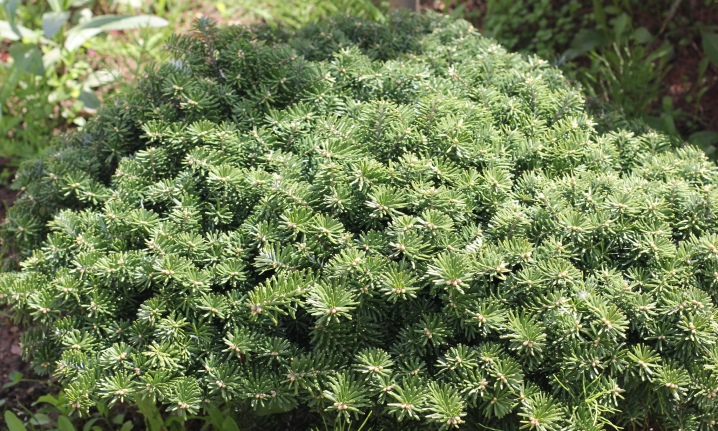
- Dwarf shrub "Tundra" has a crown circumference of 0.6 m and a height of 0.4 m. Well adapted to growing in the shade and loves moist soil. Differs in soft, short and shiny needles of bright green color with a silvery underside. The variety is used for decoration of heather and rocky gardens, rock gardens, landscaping of slopes and roofs.

- Silver Star - evergreen plant with a crown shape in the form of an irregular cone. Fir can grow up to 1 m with a circumference of the green part of 70-80 cm. It grows up to 8 cm per year. The needles are bright emerald on the outside, their inner side is white or silver in color. The compact tree produces beautiful purple cones at a young age. The use provides for single plantings and compositions with flowers, conifers, herbaceous plants.
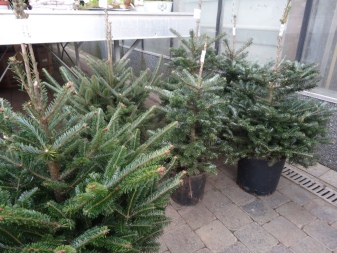
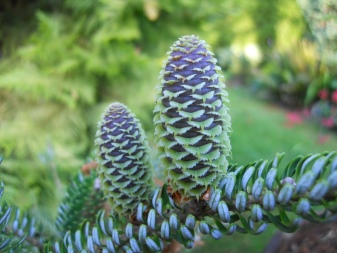
- Blue dwarf "Blue Emperor" differs in a cushion-shaped irregular crown shape. The needles are gray-blue, rounded at the ends. The variety reaches a height of no more than 1.5 m, and grows by 6-8 cm per year. Often its crown spreads along the ground, but the shoots grow vertically upwards. The culture is winter-hardy (zone 5a), it needs loose fertile soil. The Blue Emperor species has found its application in the creation of alpine slides, the design of rocky areas.
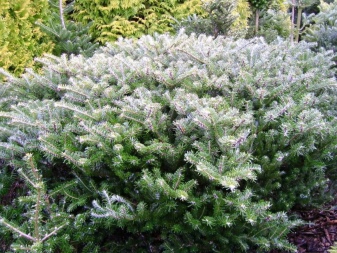

- "Blue Magic" - a small, slowly growing tree, which in adulthood has a height of about 1 m, but over the years it can grow up to 2.5 m. The shape of the crown can be cone-shaped and cushion-shaped. The peculiarity of the variety is the green-blue color of the needles during shade cultivation. In good light, the fir has a silvery-blue color. It is planted separately, as an element of garden compositions or in group plantings.
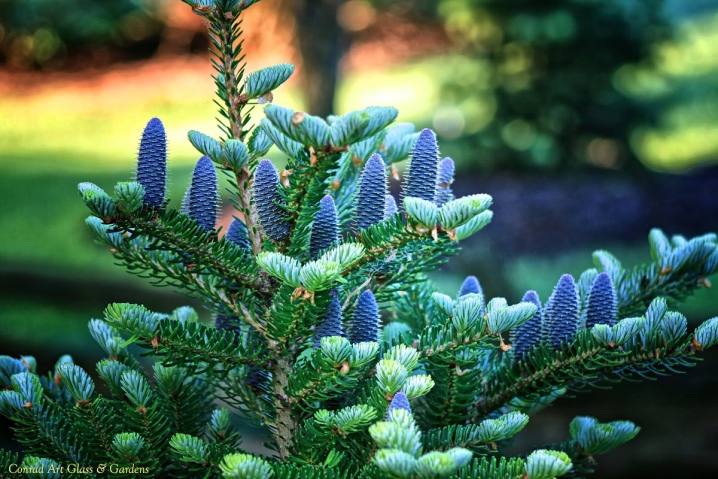
- "Oberon" - this variety of fir has rare decorative qualities. Its needles have wide and short needles, bright green outside and white underneath. As the plant grows, it reaches the same width and height - 1.5 m, and resembles a cone of irregular shape. The tree is suitable for landscaping alpine slides and small garden ensembles.
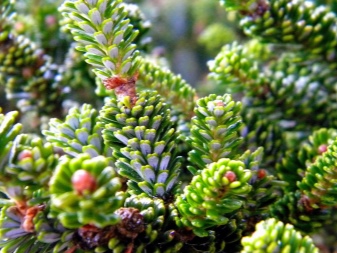
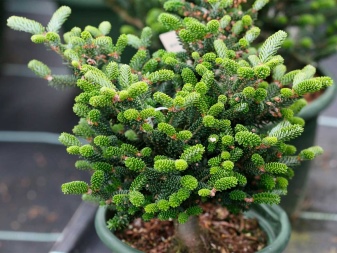
- A variety of Korean fir "Aurea" is also considered to be dwarf. As it grows, it reaches 1.5 meters, and its final height is about 4-4.5 m. The variety is famous for the magical golden color of the branches in spring, beautiful purple cones can already form on the young branches of the plant. The crown of a tree can be shaped by pruning. In terms of winter hardiness, the species belongs to zone 4, but needs protection from the wind.
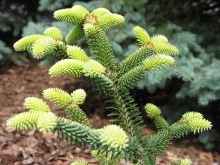
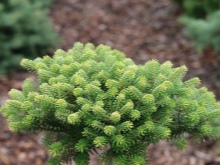
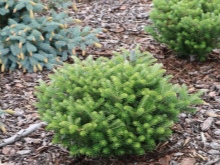
- Variety "Discus" - one of the slowest growing species, its growth per year is only 3 cm. The culture is distinguished by a white-green cone-shaped crown. Adult specimens stretch up to 1.2 m in height and reach 90 cm in width. Fir is sensitive to drafts, but is not afraid of severe frosts.
It is used as a decorative decoration in the creation of rockeries, alpine slides; it is allowed to grow crops in containers.
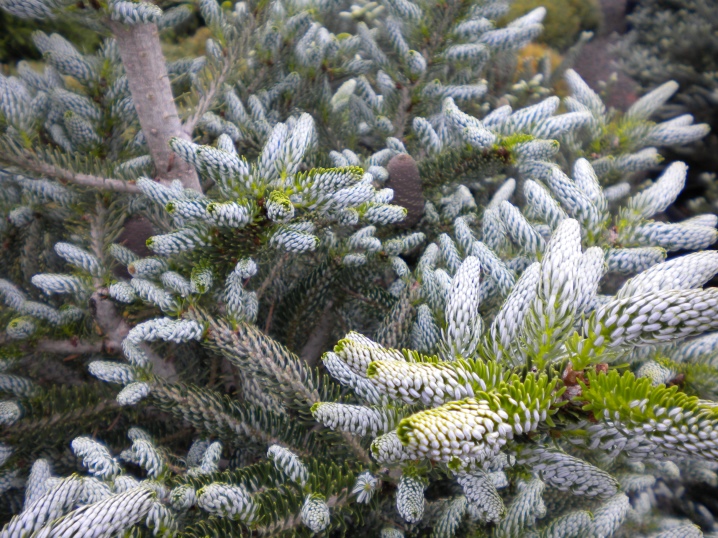
- Fir "Inga" strikes with its color, close to the shade of the sea wave. Its brightness is softened by its characteristic silvery stripes. The crown in the form of a cone is lush and thick, but due to the lack of clear geometry it looks especially original.The tree grows slowly, but as an adult, it grows to 0.8-1 m, although by the age of 30 it can reach 3-4 m. The variety is used for planting in a group, for creating park and garden ensembles, hedges.
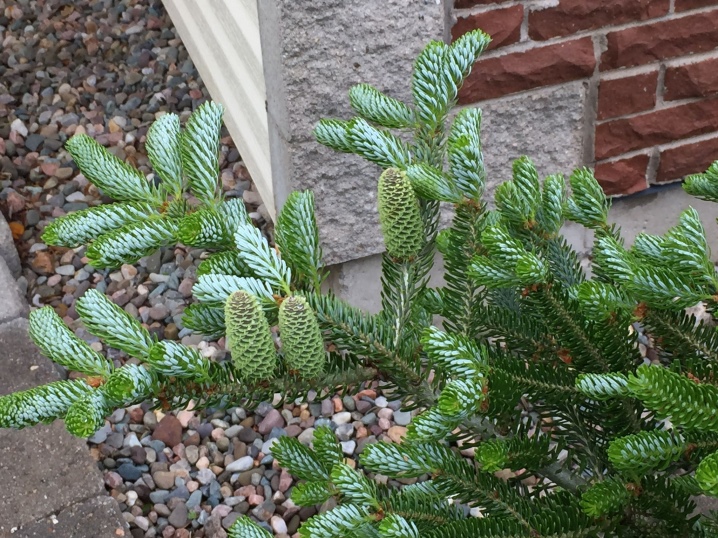
- Korean variety "Tsis" has a rounded or spherical crown, soft emerald green needles. Its purple-lilac buds are 5 cm long and grow upward. The coniferous dwarf grows 1-3 cm each year and has a crown diameter of 1 m. This species tolerates dry weather best of all, but requires good soil drainage. The green "gnome" will be an ideal decorative element in any garden arrangement. It looks good when planted in groups and in combination with other conifers and deciduous plants, including flowers and herbs.
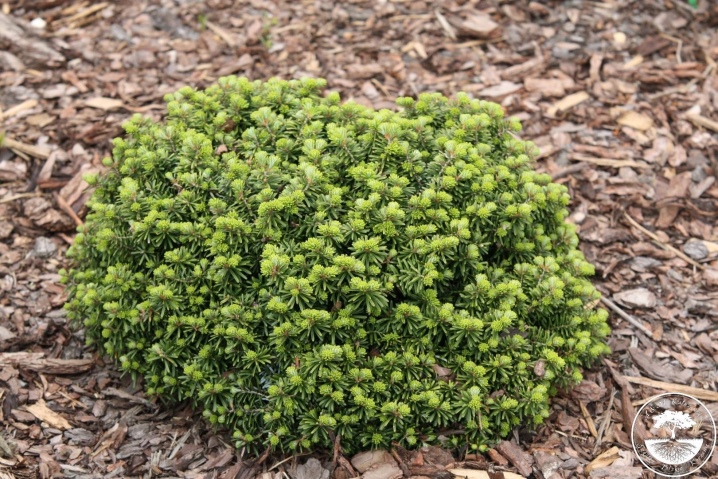
- Fir "Tanya" - a beautiful variety that has light green needles with a silvery tint. Despite its low height (1 m), the miniature species boasts large purple cones with a purple tint.
The crown of the tree lends itself to artistic pruning, it can be formed at will and in accordance with the intended design of the site. Ephedra is distinguished by frost resistance, the ability to grow on not very fertile soils. The variety is used in combination with low-growing conifers and deciduous shrubs.
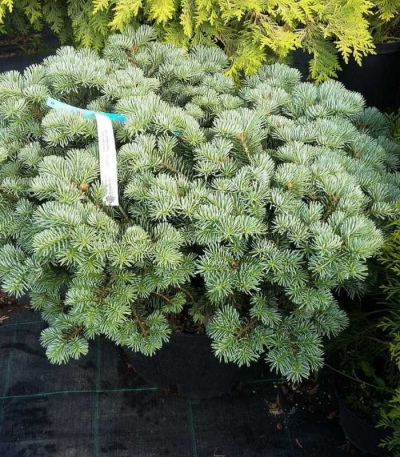
Various types of Korean fir are small in size, although some varieties can grow to a decent height in 30-40 years.
But since trees grow slowly, they are indispensable members of garden ensembles and do an excellent job of playing the role of compact decorative ornaments in parallel with other plants.
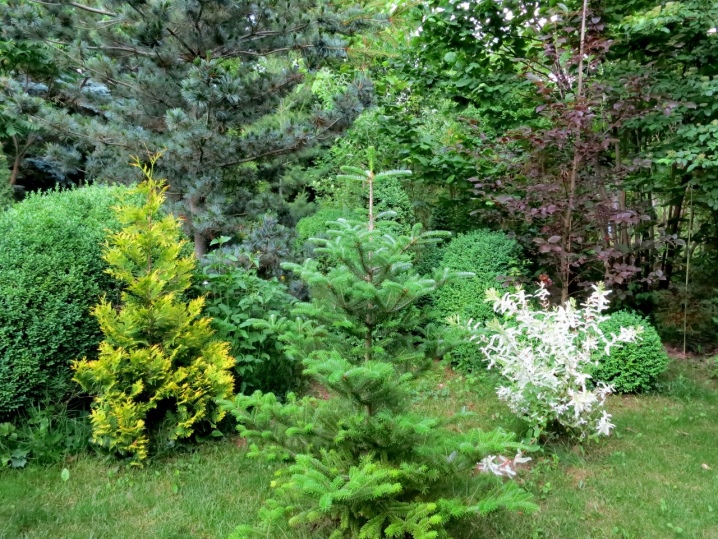
Landing
When growing a crop, you need to decide on a suitable place for planting it. Despite the unpretentiousness of the plant, a heavily shaded place is not suitable for it, besides, the fir can lose its beautiful decorative color of the needles. Therefore, it is advisable to plant the ephedra in a fairly open place, and then artificially shade the young seedlings at first.
It is good if the fir is planted in a spacious area, but protected from the winds by nearby buildings. When using a tree in different ways, it is necessary to take into account some of the nuances of its placement:
- if the Korean fir serves as one of the decorative components of rockeries or rock gardens, an interval of 3 m is observed between the seedlings;
- when creating an alley, the distance between trees must be at least 4 m;
- when the crop is intended for use in a hedge, 2.5 m is left between the plants.
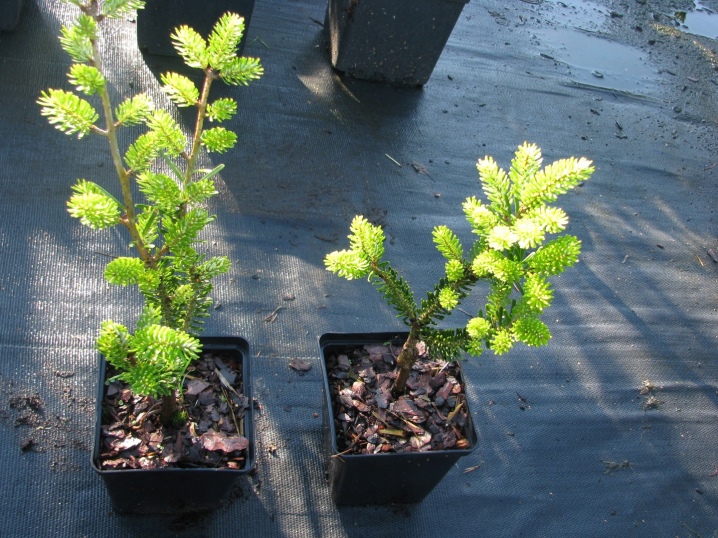
Loamy, sandy loam soil with low acidity is best suited for this plant. Two weeks before planting, it is dug up, and if it is necessary to enrich the soil, they add fertile garden soil and peat to it, with increased acidity, liming is carried out. Heavy earth, consisting of clay, is diluted with sand. Organic fertilizers are applied in a small amount (compost, humus, chicken droppings - about 8 g per 1 sq. M). You can feed the soil with potassium and phosphorus preparations, as well as urea (20 g per 1 sq. M).
Seedlings for planting are purchased at the age of 1 year, necessarily with a closed root system that can adapt in the open field. These young firs are sold in bags, sackcloth or containers.
Immediately before placing in the ground, the roots are immersed for 2 hours in a solution of a biostimulator - "Kornevin", "Epin" or "Fitosporin". Plants are best planted in April, although autumn planting is also allowed. It is correct to do this with the onset of stable warm weather and the absence of night frosts.

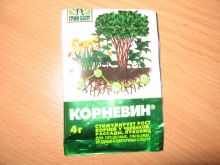
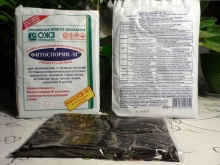
Sequencing:
- a landing hole is dug with a diameter of 60 cm and with the same depth;
- the drainage layer can be built from pieces of brick, expanded clay, pebbles and sand;
- the soil mixture is prepared from peat, turf, sand and humus, taken in the same amount, fill the hole by 2/3, adding "Nitroammofoska" (300 g), then watered abundantly with settled water;
- the plant is placed in the center of the hole, spreading its root processes; the root collar is left above the ground;
- fertile soil is poured gradually and at the same time it is compacted, after which it is watered with warm melt water.
At the end, mulching is carried out with humus, wood chips and sawdust, the layer of which is at least 8 cm.
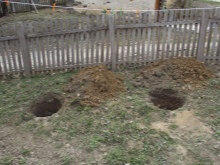
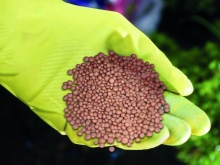
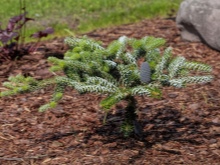
Care
The Korean ephedra, of course, can survive in adverse conditions, but in order to maintain its health and decorative appearance, it must be looked after.
Caring for culture involves various agricultural activities.
- Moistened soil is necessary for young plants, therefore, for the first 2-3 years, plants are watered regularly, avoiding overdrying of the near-trunk soil (about 10 liters per 1 seedling). During dry periods, adult firs require up to 20 liters of water per week. Also, trees should be sprayed early in the morning and after sunset, so as not to cause burns on the needles.
- For two years in a row after planting, the soil under young fir trees is regularly weeded out, loosened with a hoe no deeper than 6-7 cm in depth, and sprinkled with mulch, which prevents drying out, stagnant water and the development of diseases.
- In many ways, the successful cultivation of seedlings depends on the composition of the soil. During planting, they already receive a portion of nutrients, after which fertilization will be needed next year after the snow melts and with the onset of the growing season. For this, agricultural products such as "Kemira" are used. During fruiting, that is, the appearance of cones, the plant also needs to be fed, preferably with mineral preparations for conifers (Hera, Soft Power, Bona Forte).
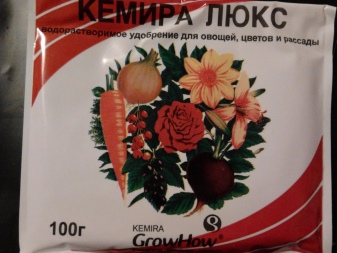
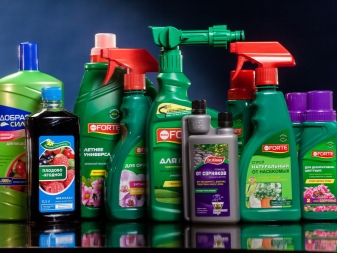
Ornamental and dwarf species of Korean fir do not need to form a crown, but they need spring and autumn sanitary pruning when diseased, dried and damaged branches are removed. In the spring, the procedure is carried out before the start of sap flow. An exception is trimming the tops of some trees to enhance branching.
For the winter, a shelter made of non-woven materials is created for young firs, after having erected a wooden frame to which they are fixed. Peat, humus, leaf litter and sawdust are poured into the near-trunk zone.


Reproduction
There are three ways to breed different types of fir. One of them - growing from seeds. This is quite difficult to do because it is difficult to collect the flying light seeds. Therefore, they take unripe buds and dry them. After that, the seeds are removed and kept cool with high humidity.
You can plant seeds in the ground or in containers so that they can be placed in open soil the next year. Cold-hardened seeds are planted in the ground in April to a depth of 2 cm, using a nutrient substrate for conifers. Seedlings create a suitable microclimate for germination, covered with foil, and provide optimal ventilation. The sprouts appear in about a month. Throughout the season, they need to be watered, and the earth must be weeded and loosened. Young plants for the winter are covered with coniferous spruce branches. Already next year, fir can be moved to a permanent place.
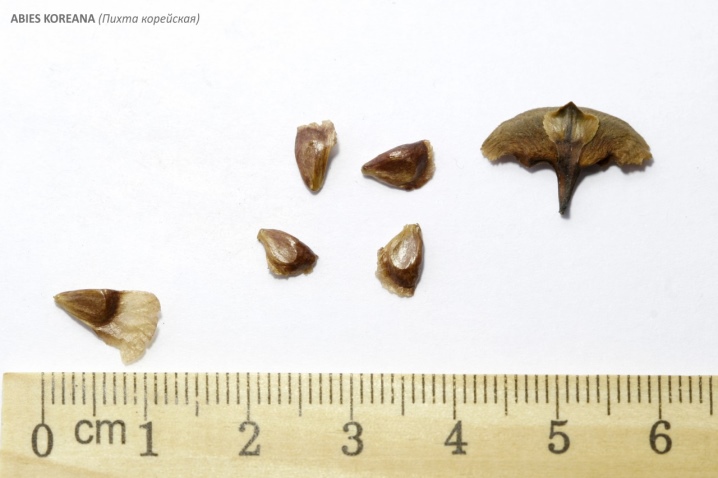
You can breed fir using cuttings. For this, in the spring of an adult plant, one-year branches with an apical bud and a "heel" are broken off. Plant diseases can be prevented by dipping cuttings into a solution of potassium permanganate. To protect the parent tree, the cut is covered with garden varnish and wrapped with plastic wrap.
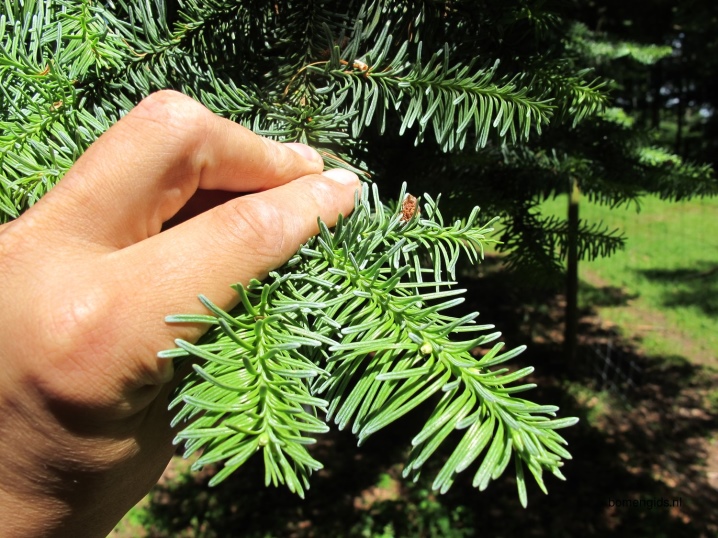
To root the twigs, you must:
- place the shoots in a mixture of sand, humus and garden soil;
- cover with glass and put in a warm place, airing every day;
- for the winter, remove to a cool, dry place, for example, in a basement or cellar;
- in spring containers are taken out into the street, and in autumn they can already be planted in open ground.
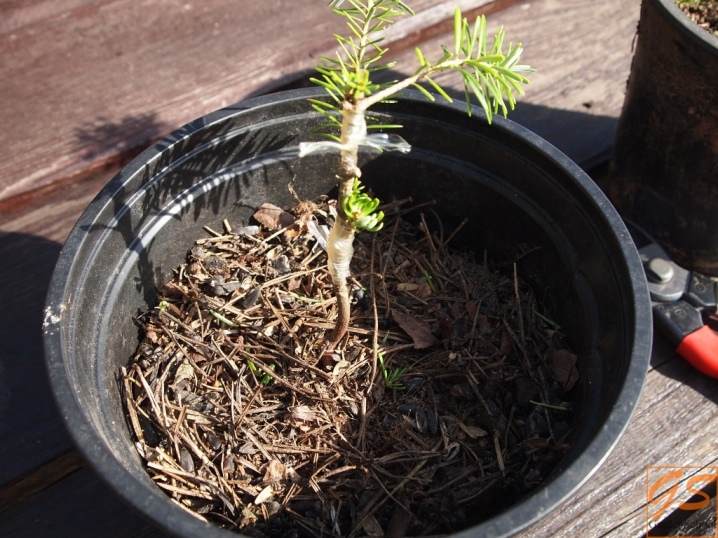
The simplest method is reproduction by layeringwhen the healthy lower shoots of the plant are bent to the soil and fixed with a bracket in a prepared furrow, deepened by 5 cm.The procedure is carried out in the spring and takes care of the plant throughout the season by watering, loosening, removing weeds and mulching with humus.
On the eve of winter, the layers are insulated and closed, and they are gradually separated from the mother fir, in several passes. New plants are transplanted after 1-2 years.
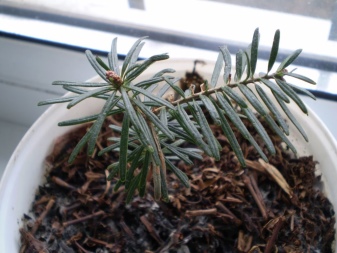
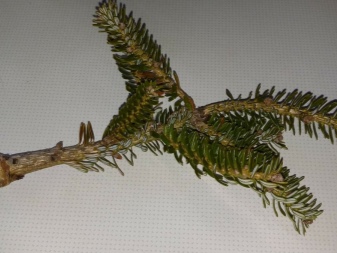
Diseases and pests
The resistance of coniferous crops to various types of pests and diseases is well known, but with illiterate care, the plant can still get sick. This is caused by excess or stagnant water. Dark brown spots appear on the branches of fir, and the needles turn yellow and crumble. These are symptoms of a fungal infection - the so-called rust. To combat the fungus, the aerial part is sprayed with a Bordeaux mixture, and the infected shoots are cut off, disinfecting the sections with garden pitch.
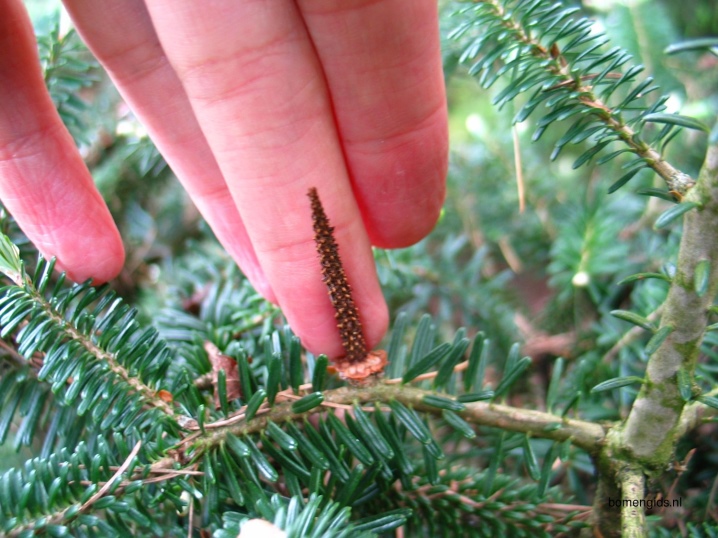
For prevention, use any means containing copper, in particular, copper sulfate. Processing should be carried out in the spring at the end of March and in April. Sometimes the problem is caused by a strong thickening of the crown, so it should be thinned out.
Of the insects, the most dangerous pest for fir is hermes - it is a close relative of phylloxera and aphids, which also parasitize on evergreen tree species. Due to their defeat, foliage is subject to wilting, yellowing and drying. It is possible to prevent the attack of insects by spraying the plantings with an "Antio" solution (for 10 liters of water you need 20 g of the substance).
Such events are relevant after the snow melts. They help prevent the appearance of other parasites - spruce shoot moth, leafworm and its larvae.
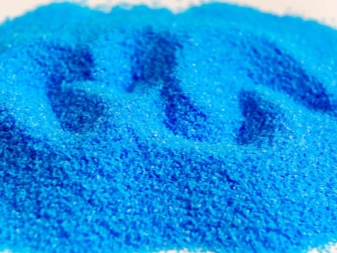
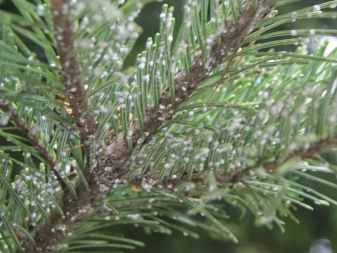
Use in landscape design
Miniature plant varieties are used for landscaping squares, parks, private gardens. Small compact trees look equally impressive individually and in groups. It is recommended to plant conifers next to them - pines, larch and spruce. Plants look beautiful next to maples, undersized ornamental and berry shrubs, creeping ground cover varieties of flowers.
Korean fir can be placed on lawns near gazebos, artificial ponds, compositions, elements of which are flowers, decorative stones, and cereal plants. The culture is suitable for decorating alpine slides, rockeries, creating a live border, and in combination with other trees - juniper, thuja, cypress, small Christmas trees. Shade-loving perennials can be planted next to the Korean fir and under its crown.
Due to its size, decorative needles, winter hardiness and unpretentious care, Korean fir has won the love and recognition of many gardeners. This explains the demand for any of its varieties and the constant interest of breeders who continue to develop new hybrid species with extraordinary characteristics.
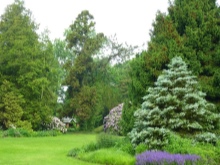


You can look at the beauty of Korean fir further.



































































The comment was sent successfully.